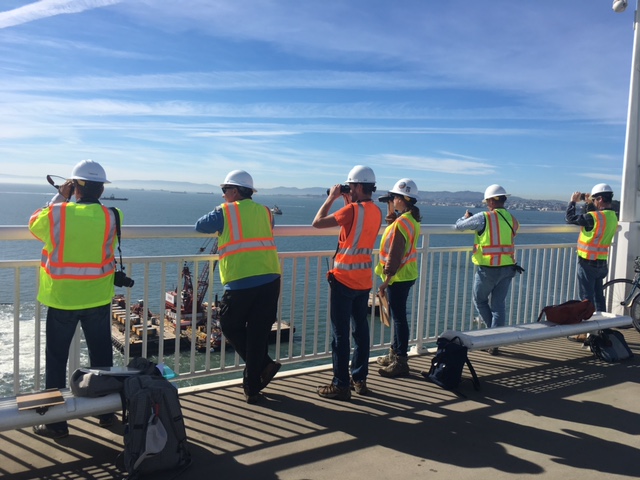OAKLAND – Caltrans continues the removal of the remaining marine foundations of the original east span of the San Francisco-Oakland Bay Bridge (SFOBB). Beginning on Saturday, Caltrans will remove Piers E4 and E5 of the Old Bay Bridge with the same implosion method used to bring down Pier E3 last fall. This method reduces the environmental impact and costs to taxpayers.
Watch the Caltrans News Flash on the upcoming implosion:
“Caltrans appreciates the guidance environmental organizations and permitting agencies provided to achieve an effective underwater demolition plan for these two 1935 east span bridge foundations,” said Caltrans Bay Area District Director Bijan Sartipi.
Pier E5 will be imploded on October 15 with 8,000 pounds of explosives, in less than three seconds. Pier E4’s implosion will occur two weeks later, on October 29 in less than four seconds, with approximately 12,000 pounds of explosives.
Significant environmental monitoring will take place pre, during and post blast, including water quality, sonar, marine mammal and fish. October provides the window when the least possible number of fish and marine mammals are present in the area. There will be brief impacts to water quality, turbidity is expected to dissipate in just over an hour and implementation is relatively easy with low risk to human safety.
A Blast Attenuation System, better known as the “bubble curtain,” will minimize impacts to biological resources in the Bay on each foundation-blasting project. The implosion will again take place near “slack tide,” the time when tidal fluctuation is at a balance point between ebb and flow to help minimize potential impacts to the environment by maximizing the effectiveness of the Blast Attenuation System.
Last November, Caltrans successfully removed the 50 million pound Pier E3, the largest of the marine foundations, by use of highly controlled sequential charges. These innovative controlled charges have been shown to be more efficient and the environmentally preferable alternative to traditional marine foundation removal.
Beginning with the implosion of Piers E4 and E5 this month, there will be three consecutive blasting seasons over the next two years. Caltrans will demolish Piers E6 through E11 in fall 2017, and Piers E12 through E18 will be removed in late 2018, when the demolition project is scheduled for completion.
There will be rolling closures on the Bay Bridge during the demolition. Caltrans will also close the bridge’s bike path. The removal of the piers on October 15 coincides with the 10th anniversary of the Treasure Island Music Festival. For more information on the festival or to send an inquiry to festival organizers, see the following links: http://www.treasureislandfestival.com
Music festival contacts page: http://treasureislandfestival.com/2016/contact/
We have limited space for media personnel and vehicles, so please confirm media attendance at Pier 1 to cover the blast by submitting name(s) to: leah_robinson-leach@dot.ca.gov
Submitted names will be placed on the media list for approved entrance at Avenue N. The media will be guided, by festival personnel, to the designated area on Pier 1.
While there are no public viewing areas, the public may watch the implosion on October 15 between noon – 12:40 pm at the following link: http://www.dot.ca.gov/oldbaybridgedemolition


